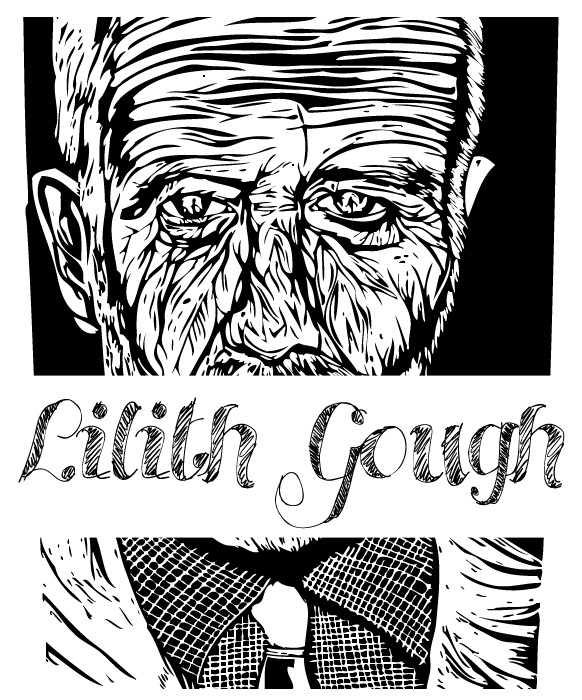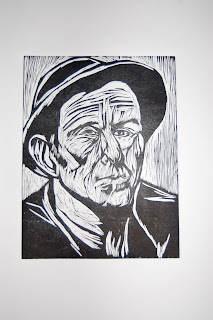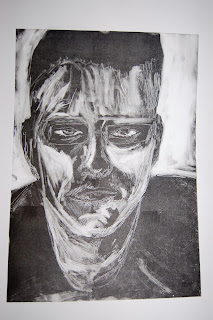Xiang Silou wood engraved print, these are truly remarkable, the skin and wrinkles are almost tangible, the show the fragility of the skin and the beauty of aging. The figures look similar to some of the amazing people I photographed in South East Asia, a man in Hoi An had similar wrinkles and visual evidence of a rich tapestry of life on his face.
Monday
Other artists working in woodcut
This woodcut by Dirk Hagner moulds the flesh through line and well thought out shade through the black blocks of ink, I would love to be able to make work like this, to use line in this way, to shape a face through line and light. The grain of the wood showing in the background add to the affect. I think this print is incredible, it stops you in your tracks it is captivating.
Sunday
Books on technique
I have begun to spend a large amount of time looking at other artists techniques in printmaking and now books like these are extremely inspiring to me, I want to learn as much as possible about how the different tools in printmaking achieve the results I see in other woodcuts, I like the way these manuals give examples of the line the tools make and how it can be used particularly in portrait printing to achieve tone.
Mono/woodcut series
Here I began to experiment with putting down a acetate plate first with colour ink rolled onto it, and then the wood cut on top of it, eventually the more I experimented I began to make the bottom layer a mono print, where I made marks into the colour, exposing some of the white from underneath it. I think the is a huge variation between the prints success according to the colour underneath it, some of them really do not work, however I think the red and yellow work well underneath the rich black ink on top.
Tom Waits
Experimenting with Japanese ply wood, this gives a different affect to both lino and MDF which is very difficult to achieve good results from.
Learning new techniques
Having worked for a while in lino and wood, I am beginning to make some progression, I think I could learn a lot more and need to read more to investigate how other artists create such detail whereas mine are more simple and much less advanced, so recently I have begun reading lots of books on techniques, and also came across a book that will perhaps change the way I work in future. My aim is to become an art therapist, therefore I am constantly reading up on art therapy and art psychotherapy and general psychology . Recently I found this book by Lucy Mueller White, who uses printmaking as a form of therapy. Seeing this book has made me think very strongly about how I want both my own practice to evolve but equally what will be of most value to me on the MFA, and I think my time will be best spent in the print department as I hope that by learning and hopefully perfecting a certain amount of skill myself in printing I might be able to come up with printing techniques that I could use in therapy, in future.
This book explains how print may have often been rejected in terms of therapy due to connotations of its expensive nature and the idea that a print studio would be needed, however she explains that print can be taken to outreach projects or to hospitals, schools and clinics and can be made possible for anyone, she also talks about the value of product, process and person, the way print can often become a group activity and the concept of editions and the multiple, it also outlines how making books of prints can be a way of binding together feelings, of containing which is an extremely important aspect of art therapy.
I have decided after reading this book not only to use print in my own work, but to keep a log of how I produce images and ways that prints might be hand done without presses, to experiment with mono prints, and collagraphs.
This book explains how print may have often been rejected in terms of therapy due to connotations of its expensive nature and the idea that a print studio would be needed, however she explains that print can be taken to outreach projects or to hospitals, schools and clinics and can be made possible for anyone, she also talks about the value of product, process and person, the way print can often become a group activity and the concept of editions and the multiple, it also outlines how making books of prints can be a way of binding together feelings, of containing which is an extremely important aspect of art therapy.
I have decided after reading this book not only to use print in my own work, but to keep a log of how I produce images and ways that prints might be hand done without presses, to experiment with mono prints, and collagraphs.
Erich Heckel
This German artist makes outstanding woodcuts, I like the way he uses gaged line and bold blacks and blocks of colour to portray his figures. They are vivid, striking and have strong impact. I want to begin to use colour in my lino and woodcuts.
After much thought
After making all the preliminary drawings and the small moquette of this portrait, I made it on large almost A1 scale. I was pleased with the result once I had managed to pull a print with good crisp blacks, I want to push this print further I hope I will work out a way of using colour onto the print. As yet I am not sure how to do this....
Amazing print-Luke Dixon
Wow, this inspires me! I love this use of line and the way he has made internal shapes within the flesh to show light and dark.
Saturday
Studio B
Studio B invited anyone to enter a postcard size entry to an open exhibition in their gallery where the artists who work within the studio would also be showing their work. I decided to enter one of my prints, a lino, it was a nice project to work on, to make an image to exactly that size, having been working on such large scale it was nice to be constricted to something smaller for a this entry, I spend a long time planning again drawing in black pen making small sketches, in the end a reduced an image down to strong lines and found this worked the best.
It was interesting to see everyones different approaches to such a simple direction. It was a chance to meet other artists at the exhibition opening.
I think my lino prints are beginning to get more successful the more I work on them, this took many preliminary drawings to decide on how to reduce the face down, I think i could do far more reduction more in the style of Tony Bevan, but in keeping with my own style of high contrast with black and white.
It was interesting to see everyones different approaches to such a simple direction. It was a chance to meet other artists at the exhibition opening.
I think my lino prints are beginning to get more successful the more I work on them, this took many preliminary drawings to decide on how to reduce the face down, I think i could do far more reduction more in the style of Tony Bevan, but in keeping with my own style of high contrast with black and white.
I entered this print into the postcard exhibition at 'Studio B' so this is only 4x6 inches.
Preliminary drawing
Having bought a large piece of lino I wanted to think very carefully about what to put onto it, and to consider it before just working straight onto it, this meant a long process of drawing and figuring out what worked and what did not, I found using black pens as a way of mapping out how the print might look and making small models of how it might look let to two drawing that I thought were quite striking as images and might work well as a print, particularly in lino using very strong lines. These drawings were my initial ideas, I than made a small version of how the print would look, and felt that it would work well on large scale.
Making a mark
The lino cut gives way to expression through mark making, I find it easier to create depth and light and dark than with woodcuts. The line creates the contours of the face, and different depth of cuts can create shading. I can see that I could learn a lot more from reading about the way the different tools can give a thicker or thinner line and you can achieve far more detail than I have so far, I have collected books on techniques of lino and woodcutters to find out new techniques.
Friday
layers-modified solar prints
These prints were variations, experimenting with juxtaposition of colour adding layers of meaning on top of the image, the colour added further dimensions, and gave the prints more graphical quality.
Subscribe to:
Posts (Atom)

































